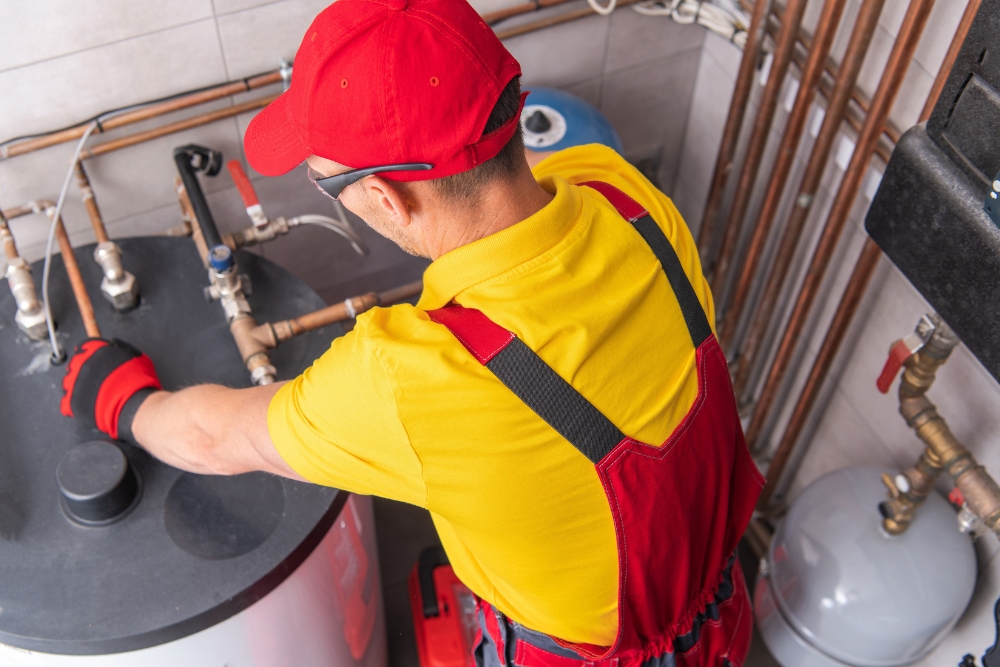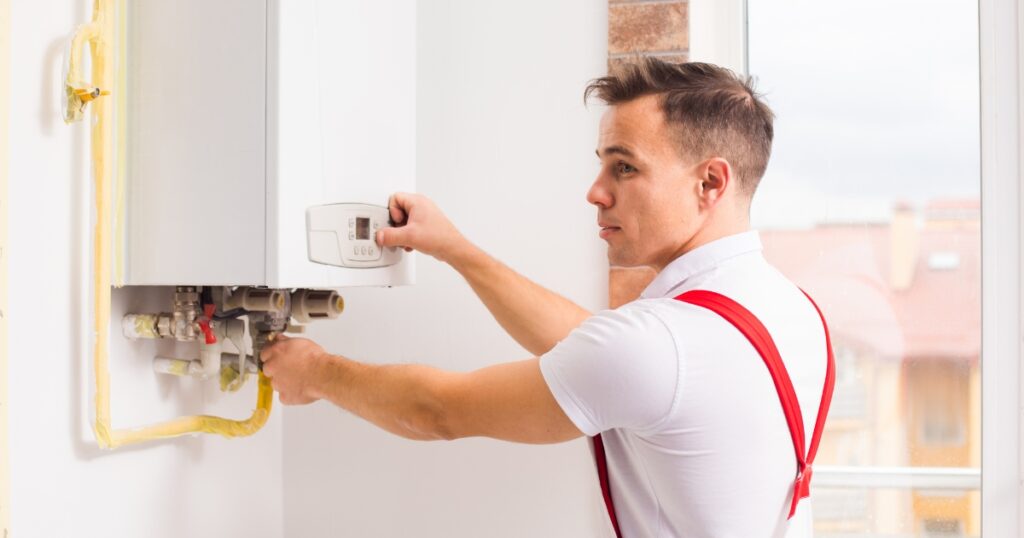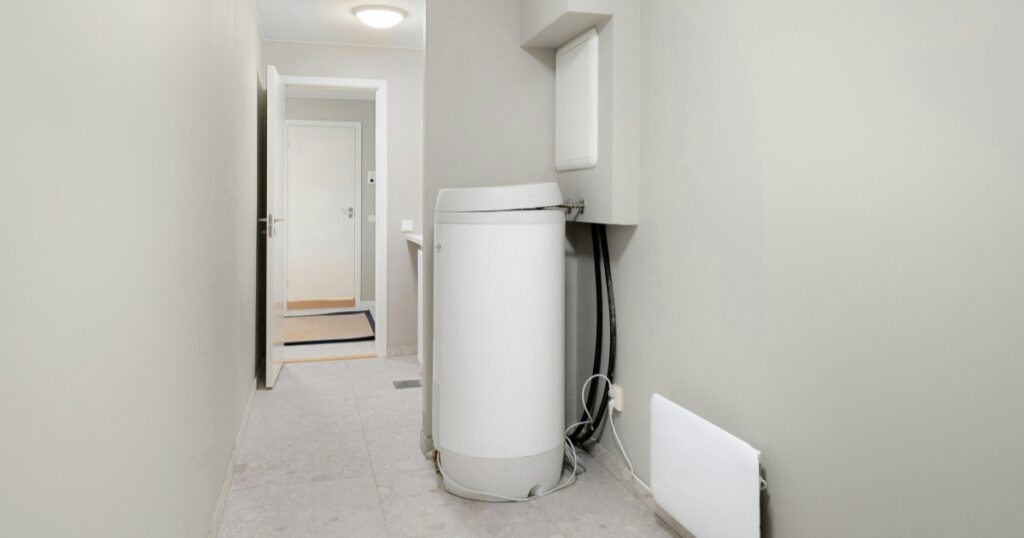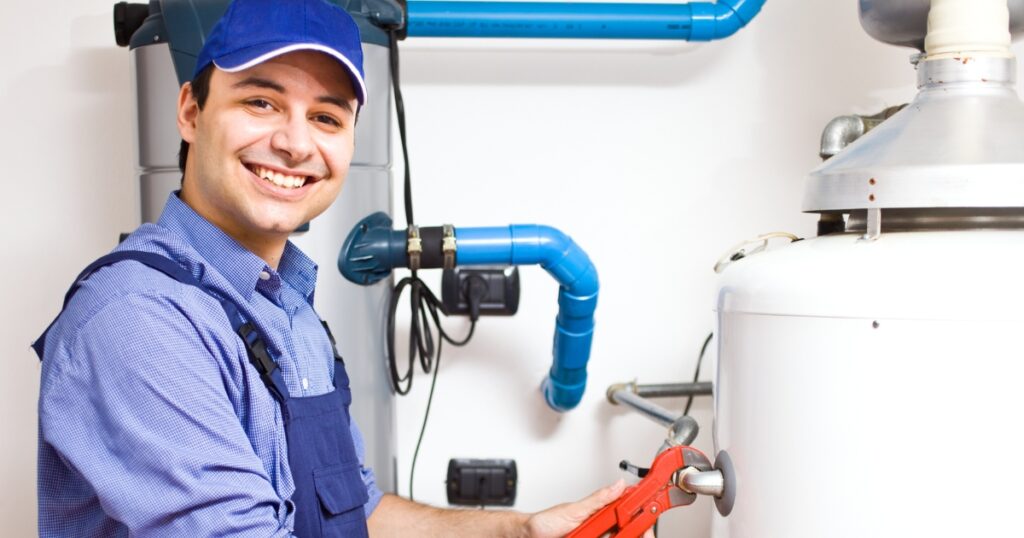Ever found yourself waiting for a nice hot shower, only to cop an earful of odd gurgling sounds from the water tank? Mate, you’re not alone. It’s a fair dinkum hassle here in Australia where 85% of our homes battle with hard water and the inevitable sediment that clogs up our hot water systems.
But don’t chuck a wobbly just yet! Our blog’s got your back – we’ll walk you through spotting those dodgy signs of grit build-up and sling you some top-notch advice on how to sort it out.
Key Takeaways
- Regular maintenance, including annual flushing of the water heater tank, is essential to remove sediment and maintain system efficiency.
- Keep an ear out for unusual noises from your water heater as they can signal sediment build-up that needs immediate attention to prevent further damage.
- Installing a whole house sediment pre-filter helps in capturing sediments before they enter the tank, extending its lifespan and ensuring clean water.
- Monitor your energy bills; unexpected increases could indicate inefficiencies in your hot water system caused by sediment insulation on heating elements.
- Watch for discoloured or strange-smelling hot water and inconsistent temperatures as signs that it’s time to check and possibly flush out your water heater tank.
Signs of Sediment Build-Up in a Hot Water Heater Tank
If you start hearing unusual sounds coming from your water heater, such as rumbling, popping, or hissing, it might be a sign of sediment build-up. Inconsistent water temperature and discoloured hot water can also indicate sediment accumulation in the tank.

Unusual sounds (rumbling, popping, hissing)
We’ve all been there, comfortably at home when suddenly our peace is shattered by unexpected noises. Now, imagine hearing rumbling, popping, or hissing coming from your water heater tank.
These sounds are not just a nuisance; they’re clear signs that sediment buildup is wreaking havoc in your system. Sediment accumulates over time and as it hardens, it can cause the water to boil violently which leads to these alarming sounds.
Let’s tackle this together because ignoring these audio warnings could lead to more serious problems down the track. Regular maintenance like flushing your hot water tank can prevent such issues before they start.
When sediment is removed from hot water systems early on, we save ourselves a lot of trouble and ensure our tanks run smoothly without any scary soundtrack accompaniments.
Inconsistent water temperature
If you notice inconsistent water temperature coming from your hot water taps, it could be a sign of sediment build-up in your water heater tank. Sediment can act as an insulator, reducing the efficiency of the heating element and leading to uneven heating of the water.
This buildup can result in some areas receiving scalding hot water while others get lukewarm or cold water. Addressing this issue promptly is crucial to ensure that you have consistent and reliable access to hot water when needed.
To prevent further issues with inconsistent temperatures, it’s important to take steps to remove sediment from your hot water tank. By flushing the tank and implementing regular maintenance, you can maintain efficient operation and avoid inconveniences caused by irregular temperatures.
Discolored hot water
If you notice discoloured hot water coming from your taps, it could be a sign of sediment build-up in your water heater tank. Sediment can accumulate over time and cause the water to appear murky or rusty.
This is more common in areas with hard water containing high mineral content. The presence of sediment in your hot water system tanks can lead to reduced efficiency, potential damage to internal components, and even pose a risk for bacterial growth.
By addressing this issue promptly, such as by flushing the tank according to recommended maintenance schedules, you can prevent further complications and ensure better quality hot water.
Leaking pressure relief valve
If you notice water pooling around the base of your water heater, it may indicate a leaking pressure relief valve. This valve is designed to release excess pressure and prevent the tank from exploding, so any leakage should be addressed promptly to avoid potential safety risks.
To troubleshoot this issue, homeowners can check for loose or damaged parts such as the T&P (temperature and pressure) relief valve or the discharge pipe. If no visible issues are found, it’s recommended to consult with a professional plumber who can accurately diagnose and fix the problem before it escalates further.
Regular maintenance checks can help in identifying these issues early on and prevent potential hazards associated with a leaking pressure relief valve.
Cracks in the tank or connections
If you notice cracks in the tank or connections of your water heater, it is crucial to address them immediately to prevent potential leaks or even more serious damage. These cracks can lead to water leakage, which can cause flooding and significant water damage in your home.
It’s important to inspect the tank and connections regularly for any signs of deterioration or cracking, as this proactive approach could help you avoid costly repairs down the line.
Regular maintenance and inspections play a vital role in ensuring that your water heater operates efficiently and safely. Addressing any issues with the tank or connections promptly can save you from potential headaches and expenses caused by a major malfunction.
Decreased hot water flow
When sediment builds up in a water heater tank, it can lead to decreased hot water flow. As the sediment settles at the bottom of the tank, it creates a barrier that reduces the amount of available space for hot water to be stored.
Over time, this buildup can restrict the flow of hot water through your plumbing system and result in reduced pressure and slower heating times.
To address decreased hot water flow caused by sediment buildup, homeowners should consider flushing their water heater tanks as part of regular maintenance. This process helps remove built-up sediments and allows for improved water flow throughout your home.
Higher gas or electricity bills
If you notice higher gas or electricity bills, your water heater might be experiencing sediment build-up. This buildup forces the system to work harder and use more energy to heat the water, resulting in increased utility costs.
Sediment acts as an insulator, making it difficult for the heating elements to efficiently transfer heat to the water. To address this issue, consider flushing your hot water tank and implementing preventive maintenance measures such as installing a sediment pre-filter for your whole house water system.
We can now delve into understanding the potential dangers of sediment build-up in water heaters and how it impacts their efficiency and performance.

Dangers of Sediment Build-Up in Water Heaters
Sediment build-up in water heaters can reduce efficiency, damage internal components, promote bacteria growth and lead to potential flooding and water contamination. For more information on the risks of sediment build-up in hot water tanks, keep reading!
Reduced efficiency and performance
Sediment accumulation in hot water tanks causes reduced efficiency and performance over time. This build-up forces the heating system to work harder to heat the water, leading to increased energy consumption and higher bills.
Additionally, sediment can act as an insulator inside the tank, making it more difficult for the water heater to transfer heat effectively. As a result, this reduces the overall efficiency of your hot water system.
To restore efficient functioning, removing sediment from your hot water tank is crucial. Regular maintenance and cleaning will ensure that your water heater operates at its optimal level, saving you money on energy costs and preventing potential damage or breakdowns due to inefficient performance.
Potential for damage to interior components
Sediment buildup in hot water tanks can lead to significant damage to vital interior components. As debris accumulates at the bottom of the tank, it creates a barrier between the heating elements and the water.
This insulation effect causes the heating elements to work harder, leading to overheating and potential damage to the tank’s interior lining or connections.
Moreover, sediment accumulation can also cause corrosion within the tank due to prolonged exposure to high temperatures. Corrosion weakens its structural integrity, increasing the risk of leaks and cracks in both electric and gas water heater tanks.
Homeowners need to address sediment buildup promptly as it poses a threat not only to their hot water supply but also to potentially expensive repairs or replacements down the line.
Risk of bacteria growth
Sediment build-up in water heaters can create a breeding ground for harmful bacteria. Bacteria such as Legionella can thrive in the stagnant water at the bottom of the tank, posing health risks when you use hot water for bathing or washing.
To prevent this risk, regular maintenance and flushing of your water heater are essential to keep the system clean and free from bacterial contamination.
It’s crucial to understand how sediment build-up in your hot water tank can lead to potentially harmful bacterial growth if not addressed promptly. Regular maintenance is key to mitigating this risk and ensuring safe, clean water for daily use.
Potential for flooding and water contamination
Sediment buildup in your water heater can create the potential for flooding and contamination. As sediment accumulates, it can lead to blockages in the tank, which increases pressure and potentially causes leaks.
Additionally, sediment can harbour harmful bacteria, leading to water contamination that poses health risks for you and your family. Regular maintenance to remove sediment is crucial in preventing these issues.
To avoid potential flooding and water contamination from sediment buildup, it’s essential to take proactive measures by regularly flushing your hot water tank according to manufacturer guidelines.
How to Remove Sediment from a Water Heater Tank
To remove sediment from a water heater tank, you can start by flushing the tank and turning off the heating elements. After allowing the tank to cool, you can drain it using a hose and turn on a faucet to aid in draining before refilling the tank.
Flushing the tank
To remove sediment from your hot water tank, follow these steps:
- Turn off the electricity or gas supply to the water heater.
- Allow the water in the tank to cool down.
- Attach a hose to the drain valve at the bottom of the tank.
- Place the other end of the hose in a suitable drainage location.
- Open a hot water faucet in your home to aid in draining.
- Open the drain valve and allow the tank to fully empty.
Turning off heating elements
To ensure safety when removing sediment from a water heater tank, it’s important to start by turning off the heating elements. This prevents any accidental burns and reduces the risk of electrical hazards. After the heating elements are turned off, follow these steps:
- Locate the circuit breaker panel for the water heater and switch off the corresponding breaker to cut power to the appliance.
- If your water heater is gas-powered, turn off the gas supply to the unit using the shut-off valve located near the gas line.
- Wait for at least 30 minutes for the water in the tank to cool down before proceeding with any maintenance or flushing procedures.
Allowing the tank to cool
To remove sediment from your water heater tank, the first step is to allow the tank to cool. This helps to prevent burns and ensures safe handling of the unit. You can begin by turning off the power supply to the water heater and waiting for the tank to cool down to a safe temperature. Once the tank has cooled, you can proceed with flushing it to eliminate any built-up sediment.
- Turning off the power supply: To prevent any risk of electrical shocks or burns, switch off the power source to the water heater.
- Waiting for the tank to cool down: Give your water heater enough time to reach a safe temperature before attempting any maintenance work.
- Proceeding with caution: Always handle your water heater with care and follow the safety precautions provided by the manufacturer.
Draining the tank using a hose
To drain the tank using a hose, follow these steps:
- Turn off the power or gas supply to the water heater.
- Attach a garden hose to the drain valve at the bottom of the tank.
- Place the other end of the hose in a drain or outside where water can safely flow.
- Open a hot water faucet in your home to release pressure and allow air into the tank as it drains.
- Open the drain valve and let the water flow out until it runs clear, indicating that sediment has been flushed out.
- Close the drain valve and remove the hose once the draining is complete.
- Refill and turn on the power or gas supply to your water heater.
Turning on a faucet to aid in draining
To aid in draining the tank, turn on a hot water faucet. This will help to release pressure within the tank and allow water to flow more freely during the draining process.
- Ensure to open a hot water faucet in your home to allow air into the system.
- This step aids in preventing a vacuum from forming in the lines, which can impede drainage.
- By opening a hot water tap, you create a vent that allows the tank to empty more efficiently.
- The flow of water through the faucet will also help carry sediment out of the tank as it drains.
- Once the draining process is complete, close the faucet and proceed with refilling the tank.
Refilling the tank
Once the tank has been flushed and cleaned, it’s crucial to refill it properly to ensure optimal performance. Here’s how to refill your water heater tank:
- Turn off the drain valve tightly.
- Slowly open the cold water supply valve to allow the tank to fill up.
- Open a hot water faucet in your home to release any trapped air from the system.
- Once steady water flows from the faucet, close it.
- Check for leaks around the connections and valves.
Preventing Sediment Build-Up in Water Heaters
To prevent sediment build-up in water heaters, it is important to flush the tank once a year and turn off the heating elements before draining. Consistently checking for signs of sediment buildup and installing a sediment pre-filter for the whole house water system can also help maintain your water heater.
Flushing the tank once a year
To prevent sediment build-up in your water heater tank, it is crucial to flush the tank at least once a year. By flushing the tank annually, you can remove any accumulated debris and mineral deposits, ensuring that your water heater operates efficiently.
This simple maintenance task helps prevent potential damage to the interior components of the hot water system while also maintaining consistent water temperature and flow. Moreover, regular maintenance such as this can extend the lifespan of your water heater and reduce the risk of increased gas or electricity bills due to reduced efficiency.
Regularly flushing your hot water tank can help dissolve sediment build-up, prevent blockages, and minimise issues like discoloured hot water or unusual sounds coming from the tank.
Turning off the heating elements before draining
Before draining the water heater tank, turn off the heating elements to prevent any damage to the system. This step ensures that no heat is being generated while the tank is emptying sediment and water.
It also reduces the risk of overheating or burning out the heating elements, extending their lifespan and preventing potential issues in the future.
When turning off the heating elements before draining, ensure that both gas and electric models are switched off at their respective power sources. For electric water heaters, locate and switch off the circuit breaker dedicated to the water heater in your electrical panel.
Consistently checking for signs of sediment buildup
Consistently checking for signs of sediment buildup is crucial to maintaining your water heater’s efficiency. By keeping an eye out for unusual sounds, inconsistent water temperature, discoloured hot water, leaking pressure relief valves, cracks in the tank or connections, decreased hot water flow, and higher gas or electricity bills, you can catch sediment buildup early on.
This proactive approach helps prevent damage to the interior components of your water heater and reduces the risk of bacteria growth and potential flooding.
Regularly looking out for signs of sediment buildup not only ensures that your water heater operates smoothly but also extends its lifespan. Taking these simple preventive measures can save you from costly repairs and replacements down the line while ensuring a reliable supply of clean, hot water for your household needs.
Installing a sediment pre-filter for the whole house water system.
To prevent sediment buildup in your whole house water system, add a sediment pre-filter. This easy-to-install device will capture and remove sediments before they enter your water heater tank, reducing the risk of sediment accumulation and potential damage to the interior components.
By regularly changing and maintaining the filter, you can ensure that your water heater operates efficiently without any impediments caused by sediment buildup.
In addition to improving the longevity and performance of your hot water system, installing a sediment pre-filter for the whole house water system also helps in preventing discoloured or foul-smelling hot water due to sediments.
Address the Sediment Build-Up in Your Space
In conclusion, addressing sediment build-up in water heater tanks is crucial for maintaining efficient and reliable performance. Regular maintenance such as flushing the tank once a year can help prevent sediment accumulation and potential issues.
By being proactive and attentive to signs of sediment build-up, homeowners can ensure their hot water system continues to operate effectively. Taking these steps will help avoid costly repairs or replacements down the line. Regular attention and care for your water heater will keep it running smoothly for years to come.






